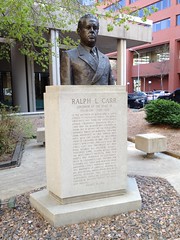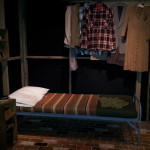WIT Life #248: Ralph Carr’s Fight for Japanese-American Justice
WIT Life is a periodic series written by professional Writer/Interpreter/Translator Stacy Smith (Kumamoto-ken CIR, 2000-03). She starts her day by watching Fujisankei’s newscast in Japanese, and here she shares some of the interesting tidbits and trends along with her own observations.

The bust in Sakura Square of former CO governor Ralph Carr, who fought for Japanese-American civil rights
My interpreting for a State Department energy-themed delegation brings me to Denver, Colorado. In the past I’ve written here about the Japanese connection at Sakura Square, where former governor Ralph Carr who took a stance against internment camps during WWII was honored with a bust in 1976. He also was named “Person of the Century” by the Denver Post in 1999. Most recently, his contributions have been recognized by naming the new Colorado Judicial Center after him. This is a 695,767 square-foot building housing the Colorado Supreme Court, Court of Appeals, Supreme Court Law Library, the State Court Administrator, the Colorado Attorney General and the Colorado Public Defender. It seems like the perfect tribute to a past politician who sacrificed his political career rather than betray the rule of law.
Carr was the 19th governor of Colorado who served from 1939 to 1943. He was in office when FDR forcibly resettled residents of Japanese descent from the West Coast to a camp at Amache near Granada, Colorado. The relocation included Nisei who were U. S. citizens by virtue of being born in this country. While many politicians pandered to the anti-Japanese hysteria, Carr stood up for Americans of Japanese descent. “The Japanese are protected by the same constitution that protects us. They have the same rights as we have. They are protected by the same courts that protect us. If you harm them, you must harm me. I was brought up in a small town where I knew the shame and dishonor of race hatred. I grew to despise it because it threatened the happiness of you and you and you,” he said in one famous speech.
In order to create the Judicial Center, the old Supreme Court building and the Colorado History Museum were torn down in 2010. The latter was reborn last year as the History Colorado Center, and it currently houses an exhibit entitled “Confined Citizens” which depicts the internment of Japanese-Americans in the state. 7318 people of Japanese descent were interned at the Amache-Granada Relocation Center from 1942-1945, and 2/3 of them were American citizens. In addition to videos with moving footage from the time, the exhibit also recreates a typical internment camp room. This spot truly captures the prison-like conditions residents were forced to endure, and includes an audio track with simulated conversations of parents trying to explain to their children about what was happening. In the videos, terminology such as “concentration camps” is used, which is a refreshing acknowledgement of what actual took place as opposed to more euphemistic language such as “relocation center.” Via institutions such as the History Colorado Center we are able to face our past, both celebrating our achievements and learning from our mistakes.



Comments are closed.